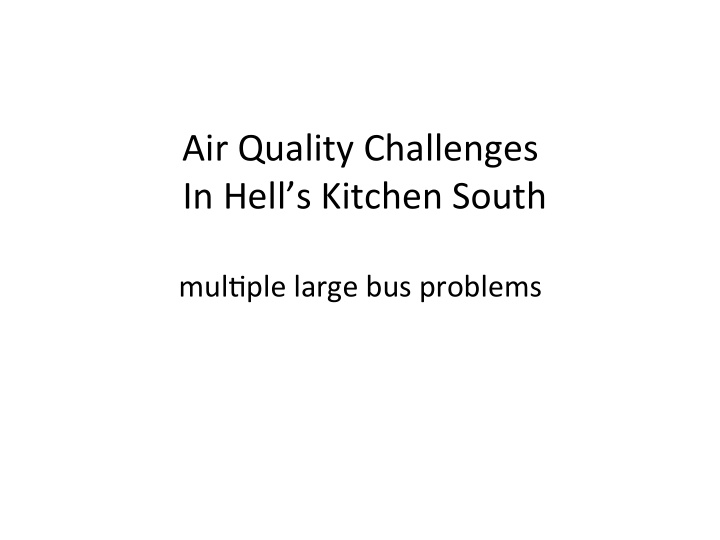



Air Quality Challenges In Hell’s Kitchen South mul9ple large bus problems
DO YOU SEE IT ?
Environmental Protec9on Agency (EPA) New York County – ManhaKan Non AKainment of Na9onal Ambient Air Quality Standards (NAAQS) hKps://www3.epa.gov/airquality/greenbook/anayo_ny.html
NYC Health Department Report Neighborhood Air Quality 2008- 2015 Hell’s Kitchen - Chelsea has the 3 rd WORST air quality in New York City 69% worse 40% worse 92% worse
NYC Health Department Report Neighborhood Air Quality 2008- 2015 Is it geBng beDer ? Nitrogen Dioxide Fine Par9culate MaKer Sulfur Dioxide 2009 2015
Motor vehicles are the major source of urban air pollu9on In Melbourne in 2006, motor vehicle emissions contributed the following levels of pollutants to the overall air quality: • 72 per cent of all carbon monoxide (CO) emissions • 70 per cent of all nitrogen oxides (NOx) emissions • 28 per cent of all vola9le organic compounds (VOC) emissions • 31 per cent of all emissions of par9cles smaller than 2.5 microns (PM 2.5 ) • 27 per cent of all emissions of par9cles smaller than 10 microns (PM 10 ) • 6 per cent of all sulfur dioxide (SO 2 ) emissions Nitrogen oxides (NOx) and vola9le organic compounds (VOCs) can combine to form ozone (summer smog).
NYC Health Department Report Neighborhood Air Quality 2008- 2015 NYC Clean Air Survey data have consistently shown that areas of the city with higher traffic density suffer from higher levels of air pollutants. 92% worse 86% worse 162% worse
NYC Health Department Report Neighborhood Air Quality 2008- 2015 How bad is it really? Lincoln Tunnel + PA Bus Terminal
NYC Health Department Report Neighborhood Air Quality 2008- 2015 How can it get worse? The study also found that trace-related PM2.5 exposures and their associated health effects dispropor9onately affect the city’s low-income neighborhoods. 9.4 1.7 X X higher levels rate of asthma of PM2.5 Emergency room visits
NYS DEC Environmental Jus9ce (EJ) October 1999 - residents from minority and low- income communi9es wanted: Access to crucial informa9on early in the permit • process Environmental jus9ce concerns included in the • environmental impact assessment (EIS) review. Equitable distribu9on of green benefits • DEC to be proac9ve in enforcement efforts • DEC to address EJ issues related to Na9ve Americans. • In EJ classified areas: EIS allows for earlier and more extensive community • consulta9ons Taken in account in the Air Permit process • DEC Grants, greening and targeted enforcement can • be obtained
NYC Health Department Report Neighborhood Air Quality 2008- 2015 Conclusion Need to reduce emissions from trucks and buses to improve the health of New Yorkers, especially the most vulnerable residents. Interven9ons directed at the most pollu9ng trucks and buses that travel roadways in the most burdened neighborhoods will maximize public health benefits and reduce health inequi9es across city neighborhoods.
Principles for improving Air Quality Fully Enclosed bus terminal Underground access to bus terminal Fully Enclosed Long Distance bus terminal + Parking Environmental Jus9ce Zone
Targeted Strategies for Various Bus Ac9vi9es Staging: High impact on air quality - queuing • NO STAGING and idling – up to 3000 buses daily + 1,000 – Commuter Buses Bus terminal : High impact on air quality - • ENCLOSED queuing and idling while loading – up to TERMINAL 3,000 buses daily + 1,000 – Commuter Buses Ramps: High impact on air quality - queuing • UNDERGROUND and idling while loading up to 3,000 buses RAMPS daily + 1,000 – Commuter Bus Curbside terminal : Limited impact on air • ENCLOSED quality because of loca9on and limited TERMINAL volumes – but loca9ons are disappearing – Long Distance buses Parking: Limited but Increasing impact on air • quality parking spots are eliminated and ENCLOSED buses idle in illegal spots or cruise around – PARKING Tour and Charter Buses
Recommend
More recommend